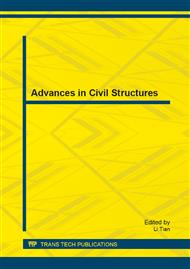p.1354
p.1358
p.1364
p.1368
p.1372
p.1376
p.1381
p.1385
p.1389
The Seismic Strengthening of a Middle School Teaching Building
Abstract:
The seismic strengthening of the teaching buildings is complex because of the difference of the seismic precautionary intensity of the buildings. This paper takes a middle school teaching building, a frame structure, as an example. The building designed without considering of the seismic precaution, and the integrity is poor and the first and second natural mode of vibration is mainly torsion deformation, which is disadvantage to the seismic performance of the building. As to this middle school teaching building, some new beams were added to the original system to strengthening the integrity and some new shear walls are added at the four external corners. After strengthening, the calculation results show that the seismic performance is increased greatly and the first and second natural mode of vibration are mainly translation deformation. Only small amount of the strengthening works are needed for the columns and beams.
Info:
Periodical:
Pages:
1372-1375
Citation:
Online since:
August 2013
Authors:
Price:
Сopyright:
© 2013 Trans Tech Publications Ltd. All Rights Reserved
Share:
Citation:


